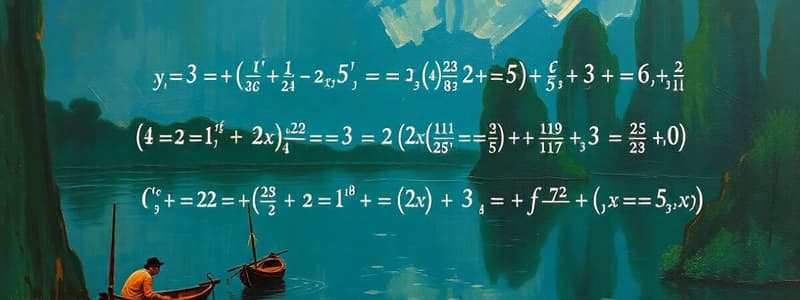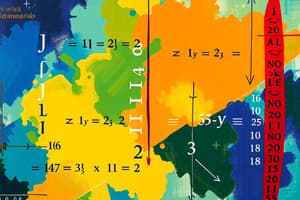Podcast
Questions and Answers
Which of the following statements about variables is true?
Which of the following statements about variables is true?
- Variables are symbols representing unknown values. (correct)
- Variables can represent known values only.
- Variables can only be letters from the alphabet.
- Variables are always constants.
What is the correct order of operations in algebra?
What is the correct order of operations in algebra?
- Multiplication, Addition, Parentheses, Subtraction, Exponents
- Addition, Multiplication, Parentheses, Exponents, Subtraction
- Exponents, Multiplication, Addition, Division, Subtraction
- Parentheses, Exponents, Multiplication and Division (left to right), Addition and Subtraction (left to right) (correct)
Which type of algebra focuses on vector spaces and linear mappings?
Which type of algebra focuses on vector spaces and linear mappings?
- Linear Algebra (correct)
- Polynomial Algebra
- Elementary Algebra
- Abstract Algebra
What is the general form of a quadratic equation?
What is the general form of a quadratic equation?
How is a linear function typically represented?
How is a linear function typically represented?
What does factoring a polynomial mean?
What does factoring a polynomial mean?
Which method can be used to solve a system of equations?
Which method can be used to solve a system of equations?
Which expression represents a radical?
Which expression represents a radical?
What is a key difference between elementary algebra and abstract algebra?
What is a key difference between elementary algebra and abstract algebra?
Which property allows you to rearrange the terms in an addition operation?
Which property allows you to rearrange the terms in an addition operation?
In solving inequalities, what happens when you multiply or divide by a negative number?
In solving inequalities, what happens when you multiply or divide by a negative number?
Which of the following correctly describes a polynomial?
Which of the following correctly describes a polynomial?
What is the highest degree of the polynomial 3x^4 + 2x^3 - x + 7?
What is the highest degree of the polynomial 3x^4 + 2x^3 - x + 7?
What type of graph would the function f(x) = ax² + bx + c represent?
What type of graph would the function f(x) = ax² + bx + c represent?
Which equation represents a linear function?
Which equation represents a linear function?
To solve the quadratic equation ax² + bx + c = 0, which of the following methods can be used?
To solve the quadratic equation ax² + bx + c = 0, which of the following methods can be used?
Which of the following statements about functions is NOT true?
Which of the following statements about functions is NOT true?
What is the primary focus of abstract algebra?
What is the primary focus of abstract algebra?
Flashcards are hidden until you start studying
Study Notes
Algebra
Basic Concepts
- Variables: Symbols representing unknown values (e.g., x, y).
- Constants: Fixed values (e.g., 2, -5).
- Expressions: Combinations of variables and constants using operations (e.g., 3x + 2).
- Equations: Mathematical statements that two expressions are equal (e.g., 2x + 3 = 7).
Operations
- Addition and Subtraction: Combine or remove values.
- Multiplication and Division: Scaling values up or down.
- Order of Operations: Parentheses, Exponents, Multiplication and Division (left to right), Addition and Subtraction (left to right) (PEMDAS).
Types of Algebra
- Elementary Algebra: Basics of algebra, focusing on solving simple equations and understanding variables.
- Abstract Algebra: Studies algebraic structures like groups, rings, and fields.
- Linear Algebra: Focus on vector spaces and linear mappings between them.
Equations and Inequalities
- Linear Equations: Form y = mx + b, where m is the slope and b is the y-intercept.
- Quadratic Equations: Form ax² + bx + c = 0; solutions found using factoring, completing the square, or the quadratic formula.
- Inequalities: Statements about the relative size of two expressions (e.g., x > 5); solutions can be graphed on a number line.
Functions
- Definition: A relation that assigns exactly one output for each input.
- Types of Functions:
- Linear: Graphs as straight lines; constant rate of change.
- Quadratic: Graphs as parabolas; variable rate of change.
- Exponential: Increases rapidly; form f(x) = a * b^x.
Polynomials
- Definition: Expressions consisting of variables raised to non-negative integer powers (e.g., 3x² + 2x - 5).
- Operations: Addition, subtraction, multiplication, and division of polynomials.
- Factoring: Breaking down polynomials into products of simpler polynomials (e.g., x² - 1 = (x-1)(x+1)).
Systems of Equations
- Definition: A set of equations with the same variables.
- Methods of Solving:
- Graphing: Finding the intersection point of the equations.
- Substitution: Solving one equation for a variable and substituting into another.
- Elimination: Adding or subtracting equations to eliminate a variable.
Exponents and Radicals
- Exponents: Represent repeated multiplication (e.g., x^n).
- Laws of Exponents: Rules for multiplying, dividing, and raising powers to powers.
- Radicals: Expressions involving roots (e.g., √x).
- Simplifying Radicals: Reducing the expression to its simplest form.
Key Algebraic Identities
- Difference of Squares: a² - b² = (a - b)(a + b).
- Square of a Binomial: (a ± b)² = a² ± 2ab + b².
- Cubic Identities: a³ + b³ = (a + b)(a² - ab + b²) and a³ - b³ = (a - b)(a² + ab + b²).
Applications of Algebra
- Problem Solving: Used in various fields like physics, engineering, economics, etc.
- Modeling Real-World Situations: Formulating equations to represent and solve real-life problems.
Basic Concepts
- Variables: Symbols such as x and y that stand in for unknown quantities.
- Constants: Fixed numeric values, including integers like 2 and -5.
- Expressions: Combinations of variables and constants, such as 3x + 2, that can be simplified or evaluated.
- Equations: Statements asserting equality between two expressions; for example, 2x + 3 = 7.
Operations
- Addition and Subtraction: Fundamental operations for combining or removing values in expressions.
- Multiplication and Division: Operations that scale values, either increasing or decreasing them.
- Order of Operations (PEMDAS): Guidelines for evaluating expressions, prioritizing Parentheses, Exponents, Multiplication and Division (left to right), then Addition and Subtraction (left to right).
Types of Algebra
- Elementary Algebra: Focuses on basic equations and the foundational concepts of variables and operations.
- Abstract Algebra: Examines algebraic structures like groups, rings, and fields, emphasizing theoretical concepts.
- Linear Algebra: Studies vector spaces and linear transformations, crucial for higher mathematics and applications.
Equations and Inequalities
- Linear Equations: Standard form y = mx + b, where m denotes slope and b signifies the y-intercept.
- Quadratic Equations: Expressed as ax² + bx + c = 0, with solutions obtained through methods such as factoring, completing the square, or using the quadratic formula.
- Inequalities: Expressions evaluating the comparative size of two quantities (e.g., x > 5), with solutions indicated on a number line.
Functions
- Definition: A mathematical relationship where each input corresponds to one output.
- Types of Functions:
- Linear Functions: Represented by straight-line graphs showing a constant rate of change.
- Quadratic Functions: Illustrated by parabolic graphs depicting variable rates of change.
- Exponential Functions: Characterized by rapid growth, expressed in the form f(x) = a * b^x.
Polynomials
- Definition: Algebraic expressions involving variables raised to non-negative integers, such as 3x² + 2x - 5.
- Operations: Polynomials can undergo addition, subtraction, multiplication, and division.
- Factoring: The process of decomposing polynomials into simpler polynomial products, like x² - 1 = (x-1)(x+1).
Systems of Equations
- Definition: Groups of equations sharing common variables.
- Methods of Solving:
- Graphing: Identifying the point of intersection on a graph to find solutions.
- Substitution: Replacing a variable in one equation with its equivalent in another.
- Elimination: Combining equations to cancel out one variable to solve for the others.
Exponents and Radicals
- Exponents: Indicate repeated multiplication of a base (e.g., x^n).
- Laws of Exponents: Rules guiding operations involving exponents for multiplication, division, and power raising.
- Radicals: Expressions that involve roots, such as √x.
- Simplifying Radicals: The process of expressing radicals in their simplest form.
Key Algebraic Identities
- Difference of Squares: a² - b² can be factored into (a - b)(a + b).
- Square of a Binomial: (a ± b)² expands to a² ± 2ab + b².
- Cubic Identities: a³ + b³ is factored as (a + b)(a² - ab + b²) and a³ - b³ as (a - b)(a² + ab + b²).
Applications of Algebra
- Problem Solving: Algebra is essential in fields such as physics, engineering, and economics for analyzing and resolving problems.
- Modeling Real-World Situations: Algebraic equations represent and provide solutions for various real-life scenarios.
Algebra Basics
- Branch of mathematics focused on symbols and their manipulation.
- Variables are symbols (commonly letters) representing unknown values.
- Constants are fixed values that do not change.
Types of Algebra
- Elementary Algebra:
- Emphasizes fundamental operations and principles.
- Involves solving equations, manipulating polynomials, and factoring.
- Abstract Algebra:
- Investigates algebraic structures such as groups, rings, and fields.
- Concentrates on theoretical principles rather than numerical calculations.
Key Concepts
- Expressions: Combinations of variables, constants, and operators (e.g., 3x + 2).
- Equations: Mathematical statements that assert equality between two expressions (e.g., 2x + 3 = 7).
- Functions: Relations whereby each input corresponds to exactly one output (e.g., f(x) = x²).
Operations
- Addition and Subtraction: Involves combining like terms and simplifying expressions.
- Multiplication: Utilizes the distributive property, illustrated as a(b + c) = ab + ac.
- Division: Functionally the inverse of multiplication.
Solving Equations
- Linear Equations: Typically formatted as ax + b = c; solutions are found by isolating the variable x.
- Quadratic Equations: Structured as ax² + bx + c = 0; can be solved through factoring, completing the square, or using the quadratic formula.
Polynomials
- Defined as algebraic expressions with terms that have non-negative integer exponents.
- The degree of a polynomial is determined by its highest exponent.
- Factoring involves decomposing polynomials into simpler elements (e.g., x² - 1 = (x - 1)(x + 1)).
Key Properties
- Commutative Property: Indicates that the order of addition or multiplication does not affect the result (e.g., a + b = b + a).
- Associative Property: Demonstrates that the grouping of terms does not influence the sum or product ((a + b) + c = a + (b + c)).
- Distributive Property: Expresses how to multiply a single term by terms within parentheses (e.g., a(b + c) = ab + ac).
Inequalities
- Defined as mathematical expressions that compare values (e.g., x > 5).
- Solving inequalities is akin to equations but requires attention to direction, such as flipping the inequality sign when multiplying or dividing by a negative number.
Functions and Graphs
- Function Notation: f(x) denotes the value of the function evaluated at x.
- Types of Functions:
- Linear Functions: Formulated as f(x) = mx + b; graphed as straight lines.
- Quadratic Functions: Expressed as f(x) = ax² + bx + c; graphs resemble parabolas.
- Exponential Functions: Modeled as f(x) = a * b^x; graphs exhibit rapid increases or decreases.
Special Topics
- Systems of Equations: Collections of equations with several variables; can be resolved through methods like substitution or elimination.
- Complex Numbers: Incorporate the imaginary unit i, defined by i² = -1.
Applications
- Algebra is integral to various fields, including engineering, economics, physics, and computer science.
- Provides a framework for modeling relationships and forecasting outcomes through equations.
Studying That Suits You
Use AI to generate personalized quizzes and flashcards to suit your learning preferences.



